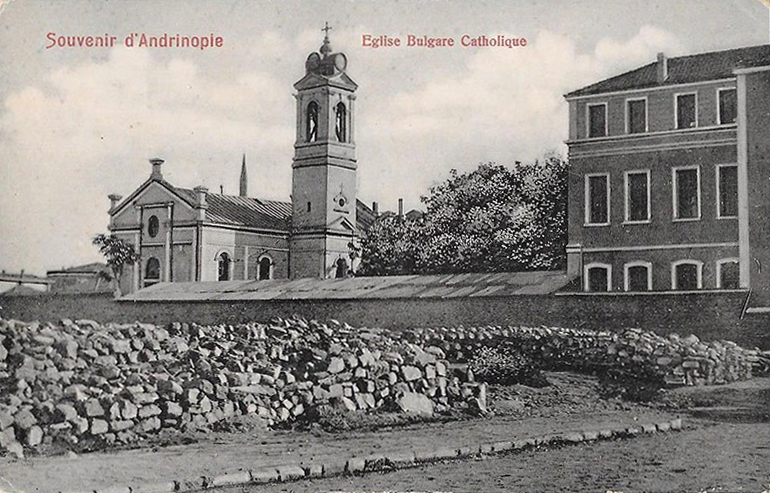

The Levantines of Edirne
The fortress of Edirne was founded by the Romans on a slope surrounded on three sides by rivers, the Meriç, Tunca and Arda. Even today, these rivers can cause catastrophic flooding. The city has always served a dual purpose; as a trading centre in the Balkans and as a military choke-point to defend Istanbul from attack from the west. Hence its occupants, at different periods, were very mixed. Edirne was ruled by the Byzantines, Bulgarians and later the Turks. It was a trading colony of Venice in the Middle Ages and the Russian army briefly occupied the city twice. Bulgarian and Greek forces vied for control of it from 1912 to 1923. Edirne, or Edrene, Hadrianopolis, Adrianople, Andrinople, Odrin or Adrianopel, as it was variously known, was very vulnerable to Great Power manoeuvring. Migrants came, communities developed; then for different reasons, they left. Like nearly all Ottoman cities, it experienced a complete turnover of population.
After conquest by the Ottomans in 1361, the largest non-Turkish community was the Greeks, born traders and shopkeepers. The Armenians were far less numerous but quite influential. The Jews, who came in large numbers from Spain and Germany, formed a sizeable community. Orthodox Bulgarians grew in number throughout the 19th century when Bulgaria was still within the Ottoman domain. The size of these communities is reflected in the number of churches they built. In the 19th century the Greeks had 10-14, the Armenians 2 (but quite large), the Bulgarians 3-4 (often small), and the Jews had 13 synagogues (wooden) until they all burnt down in the great fire of 1905 and were replaced by one, very big synagogue, still standing and newly-restored. In Edirne it was usual to build schools next to the church or synagogue since education was overseen by religious leaders. Nearly all schools had a chapel and churches/chapels had a school close by. There were exceptions, the Bulgarian Dr. Petar Beron Men’s High School (now a dormitory) for instance, but this was generally the norm.
The Levantine presence in Edirne was small and overwhelmingly Catholic. In 1693 we learn of the private chapel of a merchant from Ragusa serving as a church for the Catholics, mostly Bosnians and Hungarians (Mouton, 1967). The Capuchins had a convent here around 1738. Baptisms were recorded at the church of St Antione (Anthony) during the 18th century. (The Capuchins, like the Minor Conventuals, were Franciscans.) Levantine families were mostly French or Italian, with Germans arriving after the Vienna-Istanbul railway was built in the 1870s. The number of French-Catholic families rose from about 10 at the beginning of the 19th century to 40 in 1839 and later about 70. As with other Ottoman cities, foreign consulates were established during the 19th century, almost 15 in total, and many were represented by local merchants.
The exception to the above was George Schnell, trading in rose oil, the only British firm in Edirne in the early 19th century. He had a brother in Smyrna and his family were originally from Hannover. He was active in helping English and American missionaries establish a small Protestant church in 1862, its congregation mainly disaffected Greeks and Armenians. The flame of evangelism was more-or-less extinguished, however, when their modest chapel burnt down in 1905.
Below is a brief list of some of the leading families of Edirne, predominantly French, Austrian and Italian Catholics, who were resident up to the end of the Ottoman Empire. One or two influential Jewish, Armenian and Greek names are included. This list is preliminary and does not distinguish long-term from short-term residents. Nearly all the families were merchants or consuls, often both. Geneanet.org contains a lot more information on some of these families, e.g. Badetti and Vernazza.
|
Family name |
Individuals, notes |
|
Altinalamazi |
Peter Altinalmazi. |
|
Amirat |
(see Damirat / D'Amirat) |
|
Badetti |
Bartolomeo Francesco Badetti. August Badetti. Marc Giovanni Gaspard Badetti. Henri Francois Marc Badetti. Gustave Adolphe Badetti. Adolphe Pierre Joseph Badetti. Henri Francois Marc Badetti. Godefroy Barthelemy Emmanuel Badetti. Bartolomeo Ignatio Maria Susanna Badetti (merchant and consul, who built the St. Antoine church). Madelaine Badetti. Marie Badetti. Jean Badetti. Giovanni Battista Badetti. Seraphin Badetti. Virginie Badetti. Francesco Badetti. |
|
Barbier |
Marguerite Barbier. Honore Barbier. |
|
Belhomme |
Merchant, as in "Belhomme, Mille et compagnie" - family lineage: |
|
Bergachi (Bergo) |
Antonio Bergachi. |
|
Blunt (Blount) |
Charles Blunt. John Elijah Blunt. J. H. Blunt. George Stratford Blunt. T. E. Blunt. |
|
Boggetti |
Mavlina Bogetti. Francois Boggetti. Auguste Boggetti. Leonardo Boggetti. Emmanuele Boggetti. Francesco Boggetti (merchant, consul). |
|
Bonapace |
Marie Boggetti Bonapace. Luigi Bonapace. Maria Anna Bonapace (nee Cochino). Lucien Bonapace. |
|
Businelli |
Carlo Businelli, pharmacist. |
|
Calvert |
Edmund Calvert. Frederick Richard James Calvert. (from the Dardanelles family) |
|
Camerloher |
Gustav Wilhelm von Camerloher, Austrian consul. Guillaume de Camerloher (Camerlobe). |
|
Canetti |
Jacques Canetti (merchant). |
|
Chateauneuf |
Baron de Chateauneuf, French ambassador to Edirne 1689-1700. |
|
Cipriani |
Gabrielli Cyprianus (Cipriani). |
|
Cochino (Cokino) |
Teresa Cokine. Giovanni Cochino. Giacomo Cochino. |
|
Cumberbatch |
Henry Alfred Cumberbatch. |
|
Damirat |
D'Amirat. French and English consul. Mr Amirat. |
|
Deprez |
E. Deprez/Depre (or Depres, Desprez, maybe Desplis), French architect who designed the Grand Synagogue and proposed French church. |
|
Dorfani (D'Orfani, Orfano) (Yetim oglu) |
Jan Dorfani, Italian consul. Charles Dorfani. Marie Dorfani. Joseph Dorfani. Aldo D'Orfani, pioneer in tv broadcasting. Carlo Simone D'Orfani (Orfano). Antoine Hercule Pierre D'Orfani. Jean Baptiste Pierre Auguste D'Orfani. Henrietta D’Orfani. (Yetim = Orphan) |
|
Dupois |
Joseph Hutton Dupois. |
|
Duveluz |
Peter Duveluz. His wife Marie Anne Duveluz is buried in Buca, Smyrna. |
|
Fındıklıyan |
Leon Fındıklıyan (owner of flour mill). |
|
Flesch |
Maurice (Marie) Joseph Flesch (French consul). |
|
Fonton |
Pierre-Joseph Fonton. Louis Fonton. Anton Fonton. Maria Teophania Fonton. Caroline Adelaide Fonton. (French emigres) |
|
Georgevich (Giorgiovich) |
Constantin Georgevich. Nicolao Giorgiovich. Georgio Giorgiovic. |
|
Germano |
Guiseppe Germano. |
|
Gutowski |
Dr. Rudolph Gutowski (Polish). |
|
Honegger |
Henri H. Honegger, director of German School in Karaağaç. Denis Honegger, architect. |
|
Hussey |
Sir William Hussey - sarcophagus. |
|
Jorres |
Franz Karl Jorres, inspector on Ottoman Railways. |
|
Katibyan |
Owner of silk mill. |
|
Kerr |
John Kerr. |
|
Laskoski |
Filomena Laskoski. Joseph Laskoski. |
|
Lescaillet |
Caroline Pauline Eugénie Lescaillet. |
|
Luterotti |
Giuseppe Luterotti. Joseph Luterotti. Emilia Julia Luterotti (nee Boggetti). |
|
Macripodari |
Giovanni Macripodari. |
|
Meynard (Maynard) |
Jean Meynard (merchant). Stephane (Etienne) Meynard. Pierre-Joseph Maynard. Helene Maynard. |
|
Mircovich |
Lucia Mircovich. Demetrio Mircovich. Teresa Mircovich. |
|
Papo |
Richard Avram Papo. J. Papo. |
|
Richard |
Louis Richard |
|
Ronzevalle |
Alexandrine Béatrice Louise Ronzevalle. |
|
Roux |
Mr Roux. Jean Baptiste Roux. Jeanne Gianetta Roux. Claudine Roux. |
|
Ruffray |
Jean Louis Marie de Ruffray, sgr de la Baie de Mantresse 1748-1795 (Consul à Andrinople en 1790). |
|
Sacellarius |
Baron Geo Sacellarius. Rich merchant. Founded college. |
|
Salzani |
Olga Maria Christina Suzanna Salzani. |
|
Sperone (Speroni) |
Giovanni Baltista Sperone. |
|
Terrasson |
Andre Stephane Terrasson. |
|
Tissot |
Charles Tissot. |
|
Vernazza (Vernazzo) |
Ignazio Vernazza. Francesco Giulio Vernazza. Pietro Vernazza. Georges Angelo Vernazza. Andrea Ignatio Natale (de Giorgio) Vernazza. Frederic Joseph (de Giorgio) Vernazza. Pierre Luca Stefano Vernazza. Ange-George Vernazza. Antoine Vernazza. Elisabeth Vernazza. Christine Vernazza. Louis Vernazza. Julio Francesco (Frango) Vernazza. Frederic Joseph Vernazza. Therese Vernazza. Henriette Vernazza (nee Dorfani). Cezar Vernazza. Suzanne Vernazza (nee Fonton). Ulysses Vernazza. Lucia Vernazza. Ludovica Vernazza. Edgar Vernazza. |
|
Willshire (Wiltshire) |
William Willshire. British Vice Consul to Mogadore, Morocco 1814-1844 before assigned consul of Adrianople in 1845, until his death in 1851 at Caragatch. |
|
Zirigovich |
Jacob (Jacques) Zirigovich. Marie Anne Zirigovich. |
The Catholic denominations in Edirne are complex. The oldest group were the Friars Minor Conventual (aka Conventual Franciscans), who were in Edirne well before 1800 (though the Capuchins were here possibly earlier). The Assumptionists (men) and Oblate Sisters of the Assumption (women) arrived in 1862 and 1868, respectively. The Resurrectionists from Poland were active in Edirne from the 1860s onward. The Bulgarians were initially Orthodox but split with the Greek Patriarchate in the schism of 1872 and established their own Eastern Catholic church, known as Uniate (though in later decades it appears that the Bulgarians in Edirne gradually reverted to Orthodoxy). Considering the small size of these communities, there was mutual assistance between the Catholics in terms of staffing the churches and chapels, schools, orphanage and hospital, though there was also some rivalry.
The Levantines mostly lived in or near Kaleiçi, the walled inner part of the original city. Here was the chapel later church of St. Anthony of Padua, founded in the 18th century, built anew in 1852, burnt down in 1905, rebuilt around 1910, severely damaged by fire in 1979, and restored in 2007. This belonged to the Minor Conventuals and is still standing, used as a school meeting room. Other institutions in the following paragraphs were mostly founded in a time frame running from the 1860s, or a little earlier, and continued until 1912, 1914 or 1923.
There was also the Girls School of the Sisters of the Charity of Agram (from Zagreb, Croatia), supported by Empress Elizabeth of Austria. First a wooden building, it was rebuilt in 1911, when it seems to have come under the authority of the Institute of St. Mary of Lourdes. This grand edifice is still standing and is now the Social Sciences High School. In Kıyık was the Saint Louis Hospital run by the Oblates (the hospital was preceded by a dispensary). Lady Strangford (1838-1888) opened the Stafford House Hospital (“Anglo-Ottoman Hospital”) in Edirne in 1877-78 to treat the wounded in the Russo-Turkish War. It was extremely large, probably used a barracks for the purpose, and cared for thousands of soldiers. Two renovated Bulgarian Orthodox churches are still standing (and much visited); the Church of Saint George in Kıyık and the Church of the Saints Constantine and Elena in Kirişhane. A Greek school still stands in Kıyık, now the Fevzipaşa Primary School, and has recently been renovated. Of the Armenian church of Surp Thoros nothing now remains but several of the original school buildings (one for boys, one for girls, and a kindergarten) are currently in use as the Şehit Asım Primary School.
In Kaleiçi, the Resurrectionists founded the “Bulgarian Catholic Gymnasium” (school) with the church of St. Cyrille & Methode behind it. Both buildings are still standing. To these we must add three schools run by the Oblates: the Saint Vincent school, the school of Notre-Dame de la Merci in Kıyık, and the St. Helene girls’ school. In addition, there was the chapel of Saint Vierge, the Uniate Church of St. Demetrius in Kıyık, and the Uniate church and school of St. Elie (Elias) in Kirişhane, all managed by the Resurrectionists. Some of these schools and chapels run by the Oblates and Resurrectionists were small-scale and indeed, struggled to survive. The pupils at the schools mentioned were not exclusively Levantine or Catholic but included an interesting mix of Greeks, Armenians, Jews and Bulgarians. Some were free, others fee-paying.
Karaağaç (Karagatch, Caragatch, etc.) was once a sleepy Greek village a few miles out of town on the other side of the rivers Meriç and Tunca where the Levantines and rich merchants (including Turks) had their summer houses and farmsteads until the Vienna to Istanbul railway was constructed in 1871-73. The line ran through Karaağaç - not Edirne itself. In the 1880s, the Orient Express ran directly from Paris to Istanbul. The village turned into a boom town and the hub shifted from the east side near the river to the west side by the railroad station. Beer halls, hotels and casinos were built. And several schools and chapels. There were two Greek Orthodox churches, St. Theodoros (older) and St. Constantinos (more recent). There was the boys’ school of St. Anthony of Padua, connected to the Latin Catholic church in Kaleiçi (photos of the building today), run by the Conventuals, who also had a chapel here near the station. A “German school” was built for the children of the railway workers – the original is still standing, now the Mustafa Necati Primary School. The Assumptionists ran a boys school and the Oblates ran a girls school and orphanage. (This may be the same as the boarding school of Notre-Dame Auxiliatrice, run by the Oblates.) The Freres Maristes opened a school in 1900 which closed in 1902.
Significantly, the Assumptionists founded a seminary to prepare young boys for the priesthood, which had a chapel attached named St. Peter and St. Paul. With the rapid development of Karaağaç, the Assumptionists also established the French College (school) of St Basile, and it appears that these were all in the same location. The St. Basile College is still there. It became an ice store in later years, then Cafe Dirmen, and is now the Buzhane Davet Bahçesi, a garden venue for weddings and suchlike. The dormitory of the pupils is a separate building. Finally, the Secular “Richard” French School of Commerce was set up by Louis Richard somewhere near. Although successful, it did not survive the turmoil of the years 1912 to 1923. There were no “Italian” schools as such; they were so-named by locals because so many of the Levantines had Italian-like names. It is possible (though not yet confirmed) that some of the above-mentioned schools, etc. moved to Karaağaç suburb from the city of Edirne itself or else one morphed into another.
Many of the mentioned structures do not exist today. Wooden buildings were burnt down in fires (common in Edirne) and stone buildings were abandoned, demolished, or built over. The same applies to the Levantine, Greek, Armenian, Bulgarian, Jewish and Turkish cemeteries – there are traces of some but others are now lost forever. The bombardments of 1912-13 did a lot of damage to them.
The various communities were all active until 1912, when the Bulgarian (and Serbian) army besieged the city. It was a defining moment and traumatic experience for the inhabitants, who had to endure bombardment, deep snow, sub-zero temperatures, and a severe lack of food and wood for heating. Schools became hospitals and the sisters nursed the sick and wounded. Two years later, at the outbreak of war in 1914, the Levantine-founded institutions and communities were unable to continue since France and Britain were now the enemies of Turkey, Germany and Austria-Hungary. The establishment of the Republic of Turkey in 1923 was also a game-changer. Italy is the exception. Italian citizens seem to have been treated favourably by the new Turkish Republic after 1923 and continued living in Edirne. There was an Italian consulate and nuns continued with their school and good works.
This is just a brief summary of the “Levantine” families in Edirne and their communities before 1912, 1914 or 1923. The information was gleaned from many sources in several different languages. Bernadette Weiner, Marie-Anne Marandet and Catherine Saiko are thanked for their contribution. It is hoped that a more detailed version will be available at a future date.
Graham H. Lee, 2017
Appendix: Consuls
Below is a draft list of consuls at Edirne NOT included in the Family list. In earlier centuries when the city was more important, there was a French and English ambassador in Edirne.
Britain: P. Abbott. William Willshire (Wilshire) - his eldest daughter, Sarah Maria, married Baron Alexander Phillip Monti, Colonel in the service of the King of Sardinia, at the British consulate in Adrianople in 1850. Joseph Hutton Dupois. Major L. L. R. Samson.
Austria-Hungary: Martin Marcin. Bartolomeo Bogliacco. Carl Sax. Richard Hickel. L. Cunnelich. J. Cingria. G. de Chiari. Anton Elder Marie Von Winter. Max de Herzfeld. Dr. Arthur Chevalier de Nadamlenzki.
Bulgaria: Koujouharoff (Kocuharov?). Gourko Seraphimoff.
France: Pierre Granier. Onorato Bone. Jacques Auvelly. Charles-Etienne Malivoire. Durazzo. de Froiderfonds des Farges. Charles Francois Noel Champoiseau. Place. de Courtois. Gustave Adolphe Marie Laffon. Alexandre Jules (Julio) Theodore (Theodoro) Degrand. Albert Pinard. Charles (Carolo) Honore (Onorato) Gustave (Gustavo) Meyrier. Tynaire. Marcel (Emile-Julien) Cuinet. Parson. Eugene Jean Nicolaus Mallet. M. Pertier.
Greece: Yennadis. Philon. Napoleon Betzos. Fontana. Mihail Nikolaev. Constantin Dimaras. Nicol(i)aou.
Italy: A. Monaco. Honore Gaetani / le comte Gaetani d'Aragona di Castelmola. Carlo Raguzzi. Constantino Raganzzi.
Persia: Mirza Issa Bey. Louis (N.) Mallet.
Russia: Nicolas (H.) Flarianow. Constantino Lischine (Lisckine). Machiev. Youkovsky. Klimenko. Petropopoff.
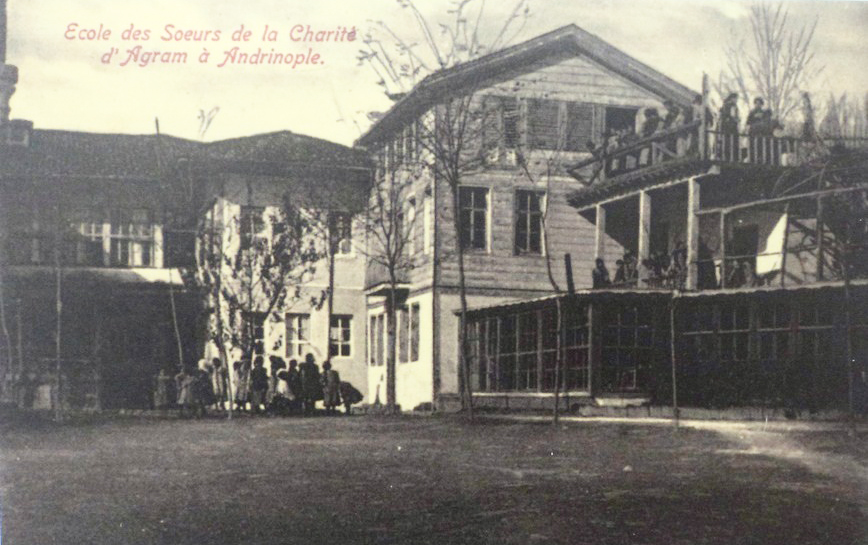
The original wooden school of the Sisters of the Charity of Agram
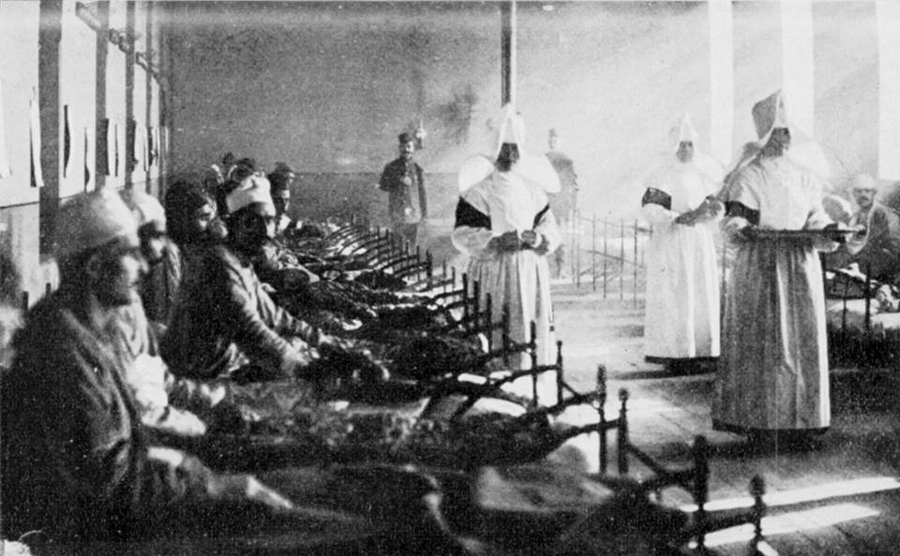
Sisters of Agram school looking after wounded at Red Cross Hospital in Karaağaç during Balkan War.
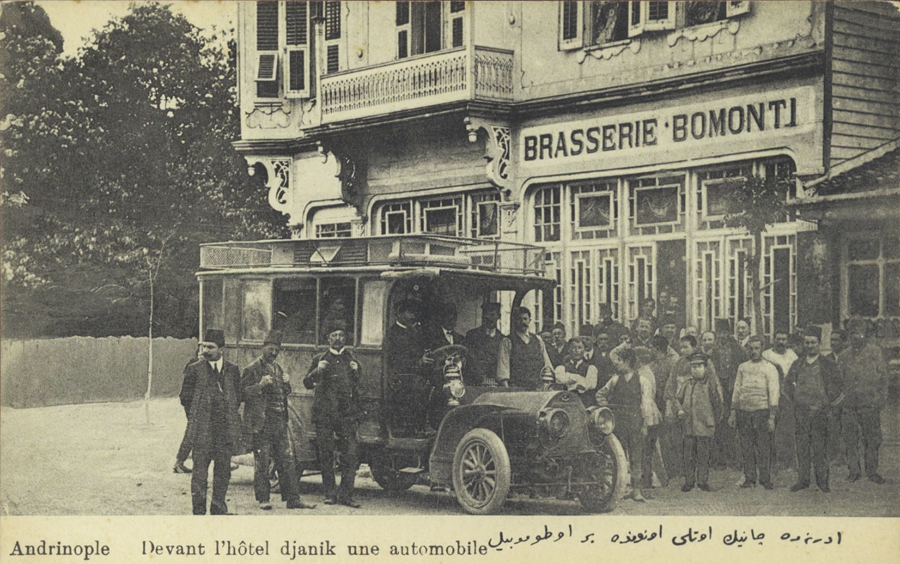
Hotel Djanik (still standing) in Karaağaç in its heyday
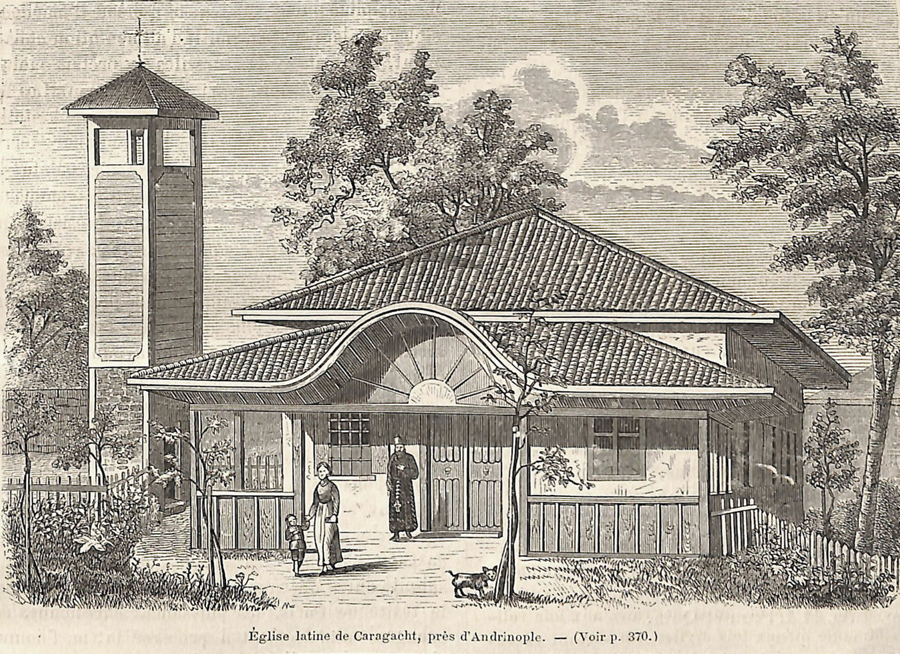
Wooden Catholic church in Karaağaç in the 1870s.
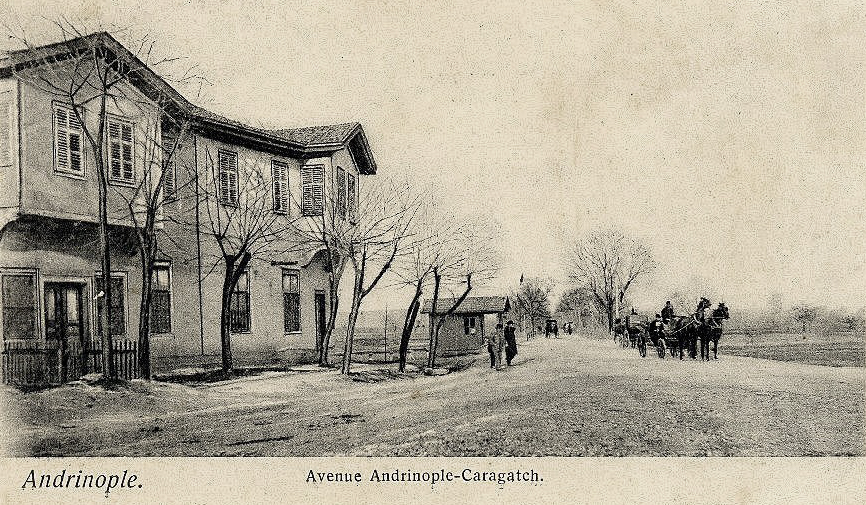
The straight avenue leading to Karaağaç. Carriages ferried passengers back and forth between Edirne and the station.
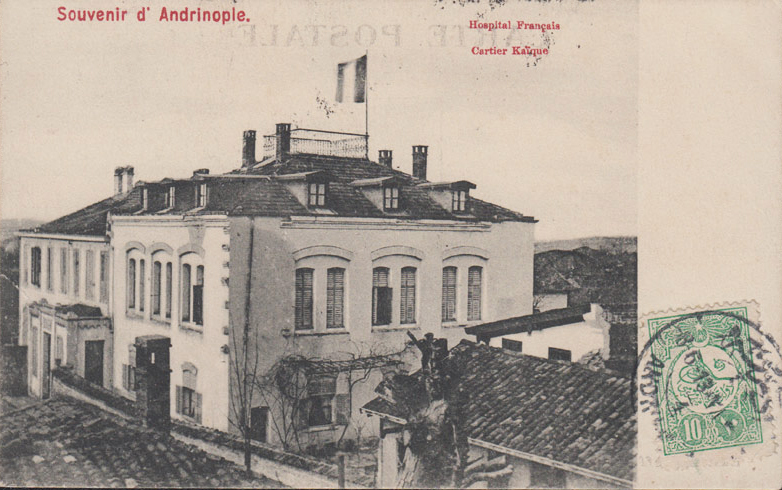
Saint Louis French Hospital in Kıyık, on the slope behind Selimiye Mosque.
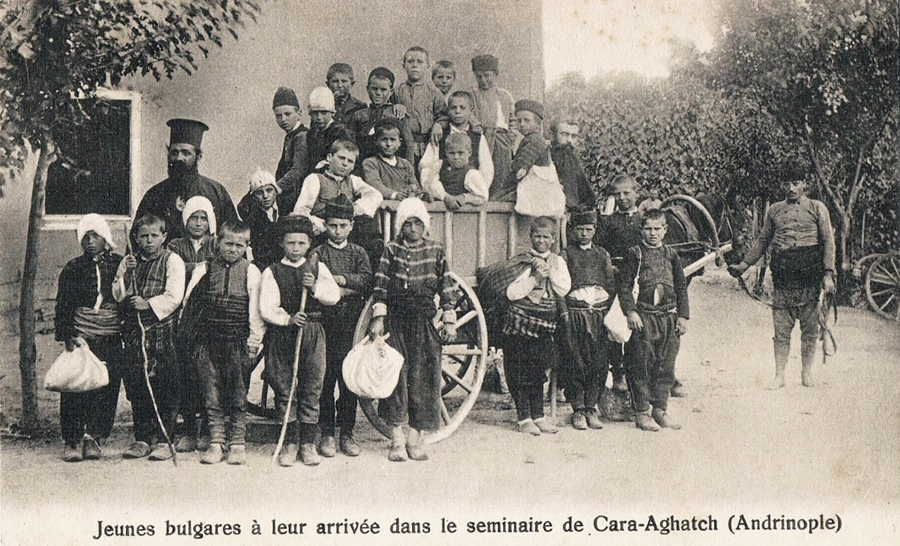
Young Bulgarians arriving at the Assumptionist seminary in Karaağaç in preparation for priesthood.
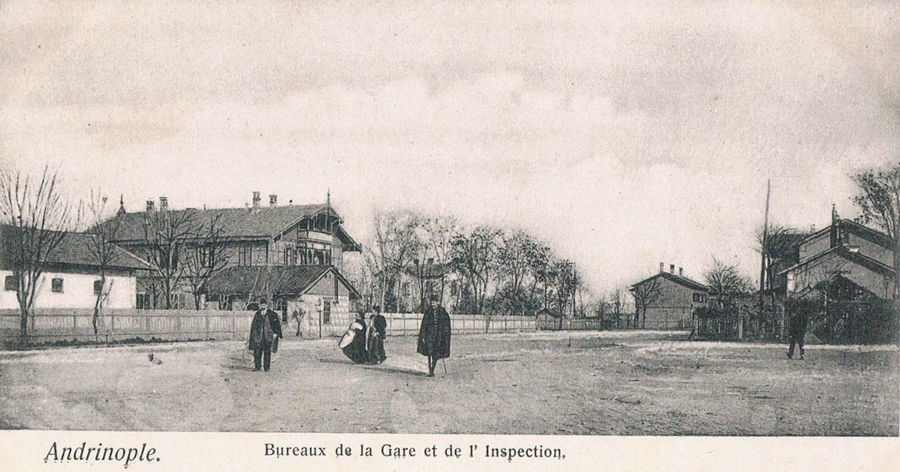
Buildings near the station at Karaağaç.
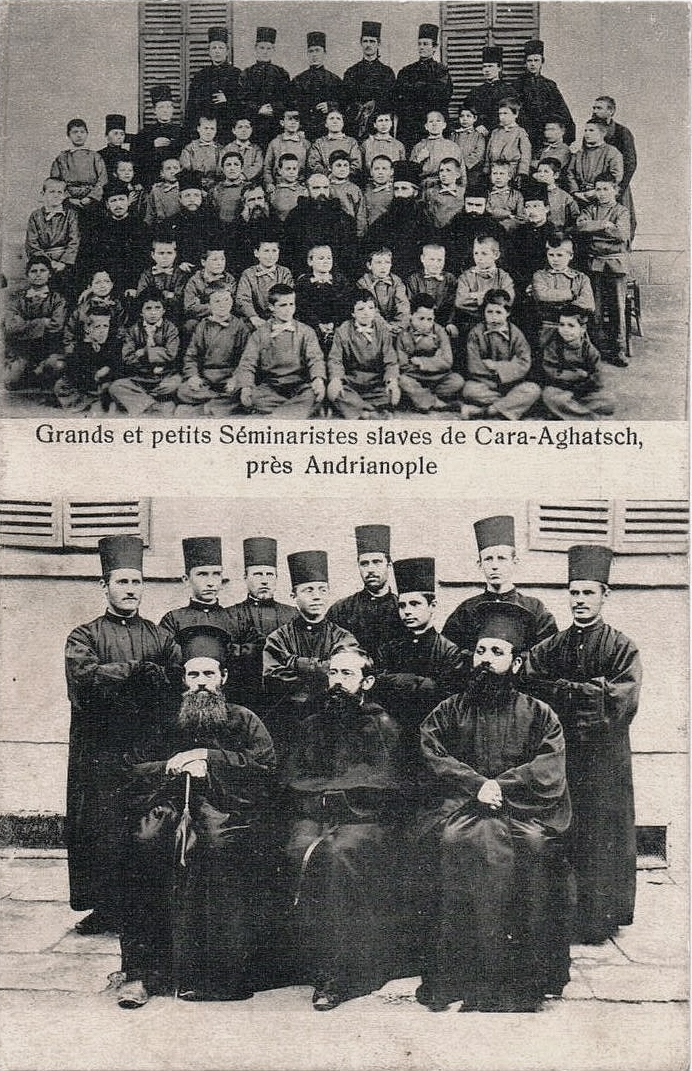
Slavic teachers and pupils at the Assumptionist seminary in Karaağaç.
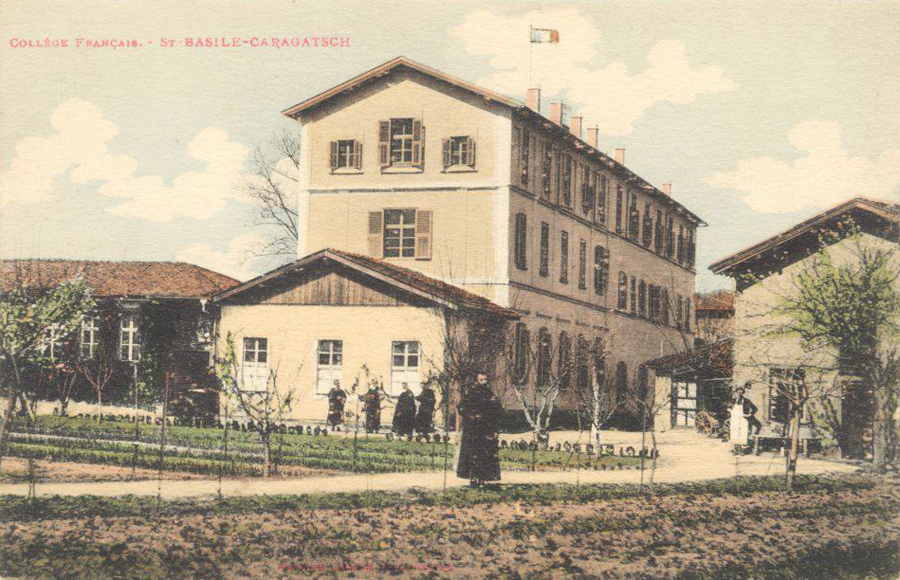
Vegetable garden behind French College of St. Basile in Karaağaç.
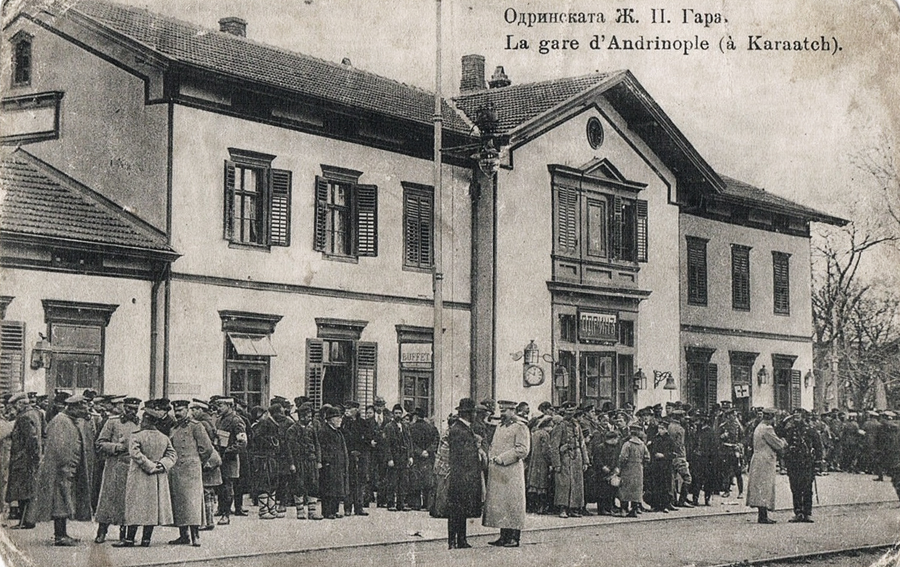
Bulgarian officers waiting at Edirne station in Karaağaç during Balkan War.
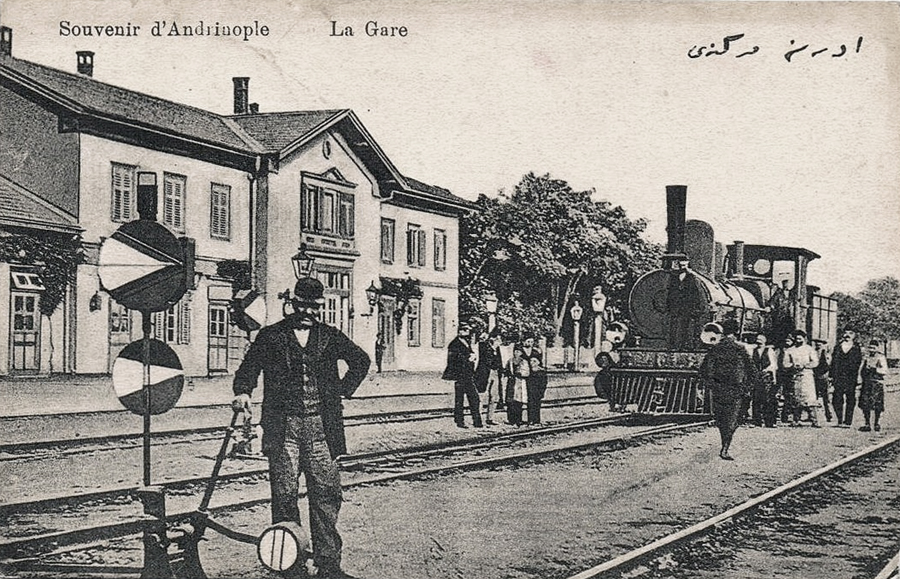
Locomotive and station at Karaağaç. The Chemins de fer Orientaux (CO) railway was founded by German financier Baron Maurice de Hirsch (1831-1896).
